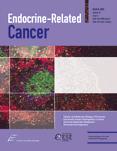Tabla de Contenido
 Endocrine-Related : Cancer
Endocrine-Related : Cancer
Vol. 16 año2009
No. 1
REVIEW
• A novel role of Shc adaptor proteins in steroid hormone-regulated cancers
• Syed Mahfuzul Alam, Mythilypriya .pág1–16
• Anaplastic thyroid cancer: molecular pathogenesis and emerging therapies .pág17–44
• Are neuroendocrine tumours a feature of tuberous sclerosis? A systematic review.pág45–58
RESEARCH
• Analysis of the oestrogen response in an angiomyolipoma derived xenograft model .pág59–72
• Incomplete surgical resection of ductal carcinomas in situ results in activation of
• ERBB2 in residual breast cancer cells.pág73–83
• Regression of progestin-accelerated 7,12-dimethylbenz[a]anthracene-induced mammary
• tumors in Sprague–Dawley rats by p53 reactivation and induction of massive apoptosis:
• a pilot study.pág85–98
• Molecular classification of spontaneous endometrial adenocarcinomas in BDII rats.pág99–111
• Autocrine stimulation of IGF1 in estrogeninduced growth of endometrial carcinoma cells: involvement of the mitogen-activated protein kinase pathway followed by up-regulation of cyclin D1 and cyclin E.pág113–122
• Expression and significance of androgen receptor coactivators in urothelial carcinoma of the bladder.pág123–137
• The single-macro domain protein LRP16 is an essential cofactor of androgen receptor.pág139–153
• Interleukin-6 stimulation of growth of prostate cancer in vitro and in vivo through activation of the androgen receptor.pág155–169
• Modification of multiple endocrine neoplasia 2A phenotype by cell membrane proximity of RET mutations in exon 10.pág171–177
• Gonadotropin-stimulated epidermal growth factor receptor expression in human ovarian surface epithelial cells: involvement of cyclic AMP-dependent exchange protein activated by cAMP pathway.pág179–188
• FOXO3a: a novel player in thyroid carcinogenesis?pág189–199
• Outcome predictors and impact of central node dissection and radiometabolic treatments in papillary thyroid cancers %2 cm.pág201–210
• Transcriptome analysis in mouse tumors induced by Ret-MEN2/FMTC mutations
• reveals subtype-specific role in survival and interference with immune surveillance.pág 211–224
• Secretive and proliferative tumor profile helps to select the best imaging technique to identify postoperative persistent or relapsing medullary thyroid cancer.pág225–231
• Identification of tyrosine 806 as a molecular determinant of RET kinase sensitivity to
• ZD6474.pág 233–241
• Sporadic hypercalcitoninemia: clinical and therapeutic consequences .pág243–253
• The clinical value of [18F]fluorodihydroxyphenylalanine positron emission
• tomography in primary diagnosis, staging, and restaging of neuroendocrine tumors.pág255–265
• Homeodomain transcription factor NKX2.2 functions in immature cells to control
• enteroendocrine differentiation and is expressed in gastrointestinal neuroendocrine tumors.pág267–279
• Metoclopramide stimulates catecholamine- and granin-derived peptide secretion from
• pheochromocytoma cells through activation of serotonin type 4 (5-HT4) receptors.pág281–290
• Mediastinal paragangliomas: association with mutations in the succinate dehydrogenase genes and aggressive behavior.pág291–299
• Frequent mutations and amplifications of the PIK3CA gene in pituitary tumors.pág301–310
• Serum IGF-I, IGFBP-3, and matrix metalloproteinase-7 levels and acquired chemoresistance in advanced colorectal cancer.pág311–317
 Salvar en InfomeDenlaceS
Salvar en InfomeDenlaceS
 RSS Artículo
RSS Artículo

